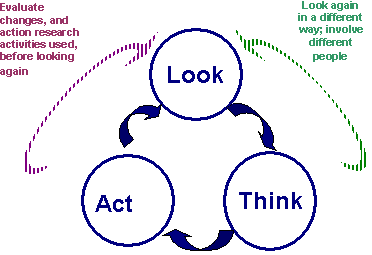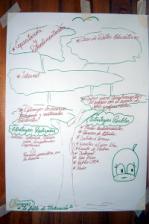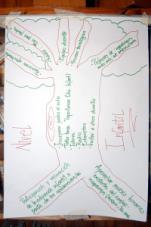Ana Luisa López

Most of the people in the IX Region of South Chile belong to the Mapuche ethnic group. They have lived there for centuries and maintain their own traditions and language, Mapudungun. They take pride in having fought the Spanish and resisted being conquered. In rural areas vulnerability goes hand-in-hand with isolation and economic difficulties, and there is little opportunity for social mobility. The IX Region suffers the highest levels of poverty in the country. In this article Ana Luisa explains how she and the teachers in a rural school used a range of EENET materials to promote discussion about inclusion, and how they were inspired by stories from Zambia. The concepts and approach used for reflection were inspired by the Index for Inclusion.
“How can it be possible that we as teachers can have so much in common, living in such different and far apart countries?”
- Teacher, South Chile
In 2004 I went to live in a small ‘commune’ (village) in South Chile in order to collaborate with teachers in an action research process. I invited 30 teachers and education staff to analyse the barriers they were facing to presence, learning and participation. I introduced them first to the Index for Inclusion, and they based their analysis on the concepts and approach recommended by this guidance resource.
I worked in a nursery, a primary and a secondary school – with 500 students in total. As I am a Spanish researcher, working together with the teachers was the first aspect to face, because we needed to establish a relationship based on co-operation and trust.
We embarked on a challenging adventure. We organised a number of one-day meetings where teachers could talk about the situation facing their school. We shared ideas and worked together to respond better to the diversity of students. A key aspect of this challenge was working in collaboration with other teachers. I found this diagram from EENET’s action research CD-ROM* useful – it helped teachers understand the process of reflection in action, and the importance of working together.
The action research cycle

Don’t rush into action; look again, gather more info; do more thinking if need be!
We also found the mind mapping ideas from the CD-ROM helpful. This led to some rich discussions on the positive and negative aspects of our school. The debates were necessary to analyse our barriers to diversity and to understand who was affected by them.
|
Mind mapping using tree diagrams
|
|
 |
 |
| Secondary teachers’ tree. Roots: ‘lack of motivation’ is the most important barrier. Trunk: strategies previously tried and possible new ones. Branches: different resources for support. |
Nursery educators’ tree. Roots: ‘Parent’s participation and valorising of early childhood education’ and ‘make better use of school human resources: Mapudungun language, folklore and ecology’. Trunk: planned activities. Branches: existing resources to use. |
The activities helped teachers to talk about the barriers their students were facing. The nursery educators expressed their concerns: they felt that some parents did not know how to support their children’s education effectively. The educators were therefore planning training sessions and radio training programmes for parents and tutors. A number of children from an orphanage attend the school. They find it difficult to follow the class routine and demand constant individual attention. It was decided to reorganise the role of the educators and teaching assistants, and the rotation of their responsibilities, in order to respond to the children’s needs and to involve them in the class dynamic.
The primary school teachers reflected on the way they were responding to students with behavioural and emotional issues. They thought about strategies they could use to reduce their absenteeism and late coming. They also felt they needed more training on how to involve students in defining class rules and in their own learning through planning, and more training on collaborative and peer learning approaches. They discussed issues around having students from the orphanage in school, and the fact that some students live in a boarding school because their homes are in the mountains, miles from the village on poor roads. These teachers also reflected on the education of disabled students who are taught in a special unit (which is part of the school) but who regularly attend some mainstream classes. The teachers expressed interest in knowing more about curricular adaptations to use in class with these students.
The secondary teachers shared some concerns with their primary school colleagues. They expressed their difficulties in encouraging families to get involved in children’s learning. In many cases, grandparents’ or parents’ first language is Mapudungun so they cannot communicate properly in Spanish. Their literacy skills are low, and they cannot help their children with schoolwork. Sometimes they have low self-esteem due to their illiteracy, and cover this by showing no interest in education. This situation jeopardizes their children’s learning process.
Most of the secondary students previously attended isolated, small, rural primary schools. When the students arrive in the village, they are not used to the dynamics of a big secondary school: the change of teachers; crowded classes; less individual teacher follow-up. They also live away from their families during the week. Teenage students tend to have few expectations for their future or opportunities for further studies, due to economic restrictions. They don’t feel confident about getting a job when they finish school.
The secondary teachers felt these could be some of the reasons why the students lack motivation and self-esteem. They reflected on ways of tackling these issues in class, and designed a plan to investigate further the needs of a group of students in the first year who had repeated the grade. They wanted to analyse if low self-esteem and motivation were influencing their performance, and felt such analysis could help develop ideas or strategies for action.
Inspiring stories from Zambia
The EENET collection of writings by teachers from Mpika, Zambia, Researching our Experience, helped us understand how teachers can research specific difficulties they face, reflect on and improve their practices. I translated some of the experiences into Spanish, and we read and discussed accounts on: absenteeism, co-operation, participation, peer support, teenage mothers, and inclusive schooling. The teachers felt really moved when they read these writings. They were very impressed when they realised that most of the problems highlighted by teachers in Zambia were shared here in Chile. This offered a powerful challenge to the teachers:
“If they could do it, we can at least try”.
I would like to thank EENET for sharing experience and knowledge, and for helping the teachers in Zambia to share theirs! It showed us that we are not alone – we share the ‘inclusion challenge’ with colleagues all over the world.
Ana Luisa is a PhD student at the School of Education, University of Manchester.
Email: Ana.L.Lopez@postgrad.manchester.ac.uk
Or contact via EENET’s postal address.
* Learning from Difference. An action research guide for capturing the experience of developing inclusive education – see Useful Publications page.
The Index for Inclusion is a set of materials for schools which guides them through a process of inclusive school development. It helps with identifying barriers to learning and participation, encourages self-review and detailed scrutiny of all school activities, and enables schools to evaluate their own progress towards developing inclusive practice. EENET is helping to disseminate experiences of using the Index in the South. The Index can be purchased from: Centre for Studies on Inclusive Education, New Redland, Frenchay Campus, Coldharbour Lane, Bristol BS16 1QU, UK. Website: www.csie.org.uk price £24.50 incl p+p (UK)
